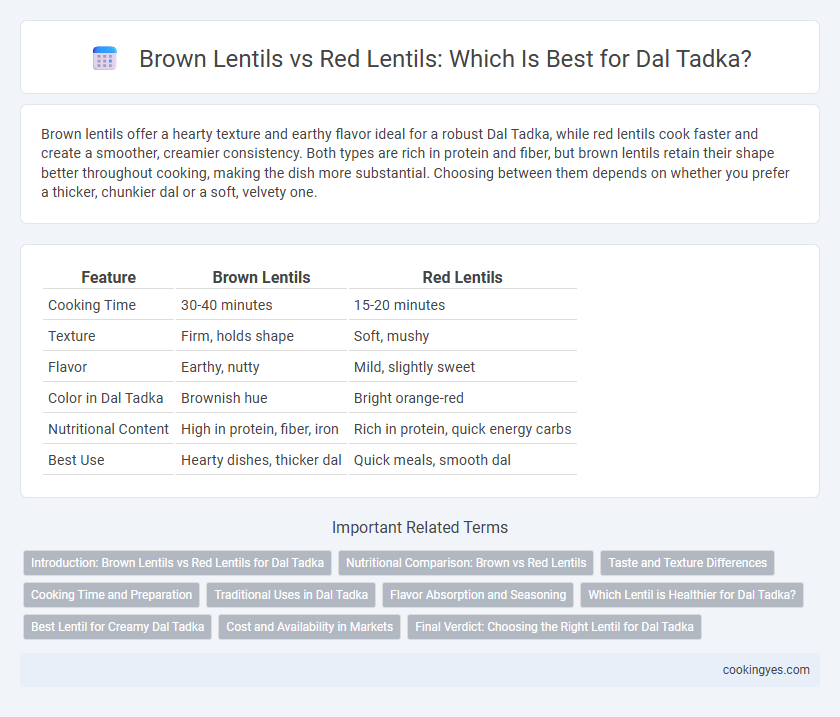Brown lentils offer a hearty texture and earthy flavor ideal for a robust Dal Tadka, while red lentils cook faster and create a smoother, creamier consistency. Both types are rich in protein and fiber, but brown lentils retain their shape better throughout cooking, making the dish more substantial. Choosing between them depends on whether you prefer a thicker, chunkier dal or a soft, velvety one.
Table of Comparison
| Feature | Brown Lentils | Red Lentils |
|---|---|---|
| Cooking Time | 30-40 minutes | 15-20 minutes |
| Texture | Firm, holds shape | Soft, mushy |
| Flavor | Earthy, nutty | Mild, slightly sweet |
| Color in Dal Tadka | Brownish hue | Bright orange-red |
| Nutritional Content | High in protein, fiber, iron | Rich in protein, quick energy carbs |
| Best Use | Hearty dishes, thicker dal | Quick meals, smooth dal |
Introduction: Brown Lentils vs Red Lentils for Dal Tadka
Brown lentils and red lentils differ significantly in texture and cooking time, impacting the flavor profile of Dal Tadka. Brown lentils hold their shape better and provide a firmer texture, while red lentils break down quickly, creating a creamy consistency. Choosing between them depends on the desired richness and thickness of the dal dish.
Nutritional Comparison: Brown vs Red Lentils
Brown lentils and red lentils both offer high protein content essential for dal tadka, but brown lentils provide more dietary fiber, aiding digestion and promoting satiety. Red lentils cook faster and have higher folate levels, supporting cell function and energy metabolism. Both varieties offer significant iron and potassium, but brown lentils have a slight edge in antioxidant content, enhancing the nutritional profile of dal tadka.
Taste and Texture Differences
Brown lentils offer a firm texture and earthy flavor ideal for Dal Tadka, providing a hearty bite that holds well during cooking. Red lentils cook faster and break down easily, resulting in a creamy consistency with a mild, slightly sweet taste that blends smoothly in the tempering spices. The choice between brown and red lentils directly influences the dal's final mouthfeel and flavor intensity, adapting to personal preference in traditional Indian cuisine.
Cooking Time and Preparation
Brown lentils typically require a longer cooking time of about 30-40 minutes compared to red lentils, which cook in approximately 15-20 minutes, making red lentils ideal for quicker dal tadka preparation. Brown lentils maintain their shape and texture after cooking, offering a firmer bite, whereas red lentils tend to break down and create a softer, creamier consistency essential for traditional dal tadka. Soaking brown lentils for 1-2 hours before cooking can further reduce cooking time and improve digestibility, unlike red lentils that generally do not require soaking.
Traditional Uses in Dal Tadka
Brown lentils, known for their firm texture and earthy flavor, are traditionally used in Dal Tadka to create a robust, hearty base that holds shape well during cooking. Red lentils, prized for their quick-cooking properties and soft, creamy consistency, lend a smoother texture and vibrant color to the dish, enhancing the characteristic tempering spices. Both lentils complement the aromatic tadka (tempering) of mustard seeds, cumin, garlic, and dried chilies, integral to authentic Dal Tadka recipes.
Flavor Absorption and Seasoning
Brown lentils offer a robust texture that absorbs dal tadka seasoning evenly, enhancing the dish's rich, spiced flavor profile. Red lentils, with their softer consistency, soak up spices quickly, creating a smooth and creamy dal with a mildly sweet undertone. Both varieties complement traditional tempering spices like mustard seeds, cumin, and garlic, but brown lentils hold the seasoning longer, providing a more layered taste experience.
Which Lentil is Healthier for Dal Tadka?
Brown lentils contain higher fiber and protein compared to red lentils, making them a healthier choice for Dal Tadka in terms of digestive health and muscle repair. Red lentils cook faster and are rich in iron and folate, beneficial for energy production and prenatal health but lower in antioxidants than brown lentils. Choosing brown lentils enhances the nutritional profile with more complex nutrients, while red lentils offer convenience and specific micronutrient benefits for Dal Tadka.
Best Lentil for Creamy Dal Tadka
Brown lentils offer a firmer texture and earthy flavor that holds well in Dal Tadka, making them less ideal for achieving a creamy consistency. Red lentils, on the other hand, break down quickly during cooking, resulting in a smoother, creamier dal that absorbs spices effectively. For a rich and creamy Dal Tadka, red lentils are the best choice due to their softness and ability to meld seamlessly with tempering spices.
Cost and Availability in Markets
Brown lentils are generally more affordable and widely available in local markets compared to red lentils, making them a popular choice for budget-conscious cooking. Red lentils tend to be slightly more expensive due to their faster cooking time and softer texture preferred in dal tadka recipes. Both types can be found in most grocery stores, but brown lentils offer better cost efficiency for frequent use.
Final Verdict: Choosing the Right Lentil for Dal Tadka
Brown lentils offer a heartier texture and earthy flavor, making Dal Tadka more robust, while red lentils cook faster and yield a creamier, sweeter dal. For a traditional Dal Tadka with a rich, textured bite, brown lentils are preferable, but red lentils suit those seeking a smooth, mildly spiced dish. Choosing the right lentil depends on desired cooking time and texture preference, influencing the final taste experience.
Brown Lentils vs Red Lentils for Dal Tadka Infographic

 cookingyes.com
cookingyes.com